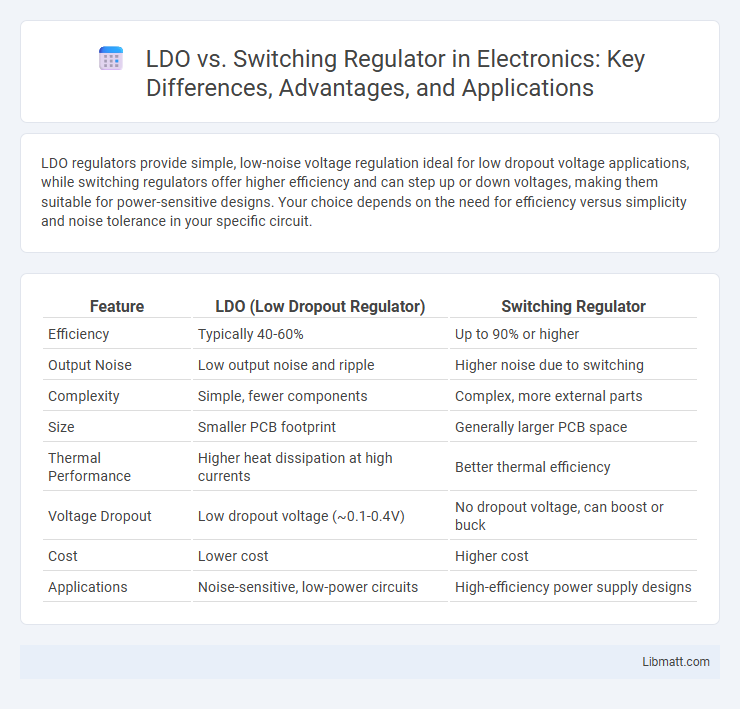LDO regulators provide simple, low-noise voltage regulation ideal for low dropout voltage applications, while switching regulators offer higher efficiency and can step up or down voltages, making them suitable for power-sensitive designs. Your choice depends on the need for efficiency versus simplicity and noise tolerance in your specific circuit.
Table of Comparison
| Feature | LDO (Low Dropout Regulator) | Switching Regulator |
|---|---|---|
| Efficiency | Typically 40-60% | Up to 90% or higher |
| Output Noise | Low output noise and ripple | Higher noise due to switching |
| Complexity | Simple, fewer components | Complex, more external parts |
| Size | Smaller PCB footprint | Generally larger PCB space |
| Thermal Performance | Higher heat dissipation at high currents | Better thermal efficiency |
| Voltage Dropout | Low dropout voltage (~0.1-0.4V) | No dropout voltage, can boost or buck |
| Cost | Lower cost | Higher cost |
| Applications | Noise-sensitive, low-power circuits | High-efficiency power supply designs |
Introduction to Voltage Regulators
Voltage regulators maintain a constant output voltage regardless of input voltage variations or load changes, with LDO (Low Dropout) regulators providing simple, low-noise linear regulation ideal for low-voltage differentials. Switching regulators, such as buck or boost converters, use high-frequency switching and energy storage elements to achieve higher efficiency, especially in applications with significant voltage step-down or step-up requirements. Selection between LDO and switching regulators depends on factors like efficiency, output noise, thermal dissipation, and complexity relevant to the power supply design.
What is an LDO (Low Dropout Regulator)?
An LDO (Low Dropout Regulator) is a type of voltage regulator designed to maintain a steady output voltage while operating with a very small input-to-output voltage differential, typically less than 1 volt. It is ideal for applications requiring low noise and high efficiency at low voltage drops, such as powering sensitive analog circuits or battery-powered devices. Understanding your power requirements will help determine if an LDO or a switching regulator better suits your design for optimal performance and efficiency.
What is a Switching Regulator?
A switching regulator is a power supply device that efficiently converts electrical energy by rapidly switching on and off transistors to regulate output voltage. It uses inductors, capacitors, and diodes to store and transfer energy, minimizing power loss compared to linear regulators like LDOs. Your choice between LDO and switching regulators depends on factors like efficiency, heat dissipation, and complexity in your application.
Key Differences Between LDO and Switching Regulators
LDO (Low Dropout) regulators provide a simple, low-noise, and efficient solution for voltage regulation with minimal dropout voltage, making them ideal for low-current applications requiring clean output. Switching regulators, however, offer higher efficiency across a wide input voltage range by using inductors and capacitors to convert power, but they introduce more electrical noise and complexity. Your choice depends on balancing efficiency needs, noise sensitivity, and complexity constraints in your electronic design.
Efficiency Comparison: LDO vs Switching Regulator
Switching regulators typically offer higher efficiency, often between 80% to 95%, because they convert voltage by rapidly switching on and off, minimizing power loss. In contrast, LDO (Low Dropout) regulators usually operate with efficiencies around 40% to 70%, as they regulate voltage by dissipating excess power as heat. Your choice depends on application needs; switching regulators are ideal for battery-powered devices requiring long runtime, while LDOs suit low-noise, low-dropout applications despite lower efficiency.
Noise Performance and EMI Considerations
LDO regulators excel in low noise performance, providing minimal output ripple and excellent transient response, making them ideal for sensitive analog and RF applications where noise and EMI must be minimized. Switching regulators generate higher electromagnetic interference (EMI) due to their high-frequency switching operation, requiring careful PCB layout, shielding, and filtering to manage noise emissions effectively. Your choice depends on balancing efficiency and noise requirements, with LDOs preferred for low-noise environments and switching regulators suited for power efficiency despite their increased EMI challenges.
Thermal Management and Power Dissipation
Linear Dropout Regulators (LDOs) generate significant heat due to their voltage-drop-based regulation, resulting in higher power dissipation that requires careful thermal management, such as heat sinks or thermal pads, to prevent device failure. Switching regulators, by contrast, operate with higher efficiency and lower power dissipation, producing less thermal stress and often eliminating the need for extensive heat dissipation measures. When designing Your power supply, factoring in these differences ensures optimal thermal performance and system reliability.
Application Scenarios for LDO and Switching Regulators
LDO regulators excel in applications requiring low noise and simple design such as audio devices, RF circuits, and low-power sensors where minimal voltage drop and fast transient response are essential. Switching regulators are ideal for high-efficiency power conversion in battery-powered devices, LED drivers, and industrial equipment where energy savings and thermal performance are critical. Choosing between LDO and switching regulators depends on factors like input voltage range, output current requirements, and sensitivity to noise in the application environment.
Design Considerations and Selection Criteria
LDO regulators offer simplicity, low noise output, and minimal component count, making them ideal for low voltage drop applications with moderate current demands, while switching regulators excel in high efficiency and heat dissipation for higher power levels. Selection criteria depend on factors such as input-output voltage differential, power efficiency requirements, thermal management constraints, and electromagnetic interference sensitivity. Design considerations also include transient response needs, PCB space availability, and overall system cost to determine whether an LDO or switching regulator best suits the application.
Conclusion: Choosing the Right Regulator for Your Needs
LDO regulators provide simple, low-noise voltage regulation ideal for low power and noise-sensitive applications, while switching regulators offer higher efficiency and better heat dissipation suitable for high power demands. Your choice depends on factors like power efficiency, thermal management, size constraints, and noise tolerance. Evaluate these parameters to select the regulator that best aligns with your project's performance and reliability requirements.
LDO vs Switching Regulator Infographic

 libmatt.com
libmatt.com